Mentryville and the UFO Cafe - by Bill Rundberg (1990)
Copyright © 2009 Bill Rundburg. All rights reserved.
Used by Permission of Bill Rundburg.
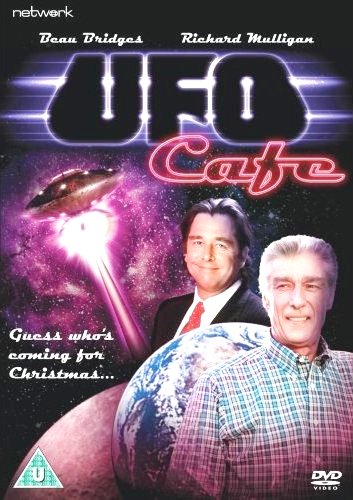
UFO Cafe is available in Europe but not in the U.S.
As it has been for decades, the road past the entrance to Dead Cow Canyon on the way up Pico Canyon to Mentryville is mostly broken pavement, potholes and dusty gravel. Before the pavement, it was a dirt road, for horse-drawn wagons and then for automobiles. And before that, back to the middle of the nineteenth century, it was a trail for mules and horses used in establishing the first producing oil field in California. Early development of that field by the California Star Oil Company and the Pacific Coast Oil Company, beginning in the late 1860's, preceded formation of the Standard Oil Company of California. Some distraction from today’s rattling ride up that road is provided by the sight of rocky, sandy hills covered sparsely with green and gray California dry-climate vegetation.
Mentryville is a ghost town about five miles west of Newhall where Pico Canyon narrows to little more than enough to accommodate the road, and the creek that shaped the canyon. The town is on property now owned by the Standard Oil Company of California, and which includes the oil field and some grazing land. Access to the property is through a gate, usually locked, about three miles west of Interstate 5; at this point the canyon road runs approximately north and south, and entrance to the property is southward. Since the late 1930's, the collection of remaining buildings has comprised a large house – some called it the “big house” -- with its separate wash house and ice house; a garage; a chicken house; two barns; a small house across the creek from the large house; various smaller buildings at various times and, up the road a hundred yards or so, a one-room schoolhouse no longer in use and its outbuildings. Most of the buildings are near the gate. Viewed from the gate, the large house and schoolhouse are on the right (west) side of the road, the other buildings on the left. Still farther up the road at the other end of the old village is the foundation of a building that housed the bakery in busier times.
In the latter nineteenth century and early part of the twentieth, Mentryville was a clump of family homes and enterprises, and it was the company town for and gateway to the oil field, which occupied gullies, hillsides and hill tops farther up the canyon. The house – its first occupants were the family of Charles Mentry, a pioneer of the oil field – has been occupied for most of the time since the rest of the community faded away.
The occasion of my first visit to Mentryville, in 1948, was preparation for living there. My family moved to the house in 1948 and eventually left in 1953. When we moved there, we were my parents, my sister June, Doug Higley – he was a year ahead of June in school and was living with us – and I. My father, an employee of the Standard Oil Company, rented the house with access to several hundred acres that we used for grazing a few livestock, from the Company. When Sherrean and I visited there recently after my absence of many years, the road had changed some, only through deterioration, from when I first saw it more than forty years before.
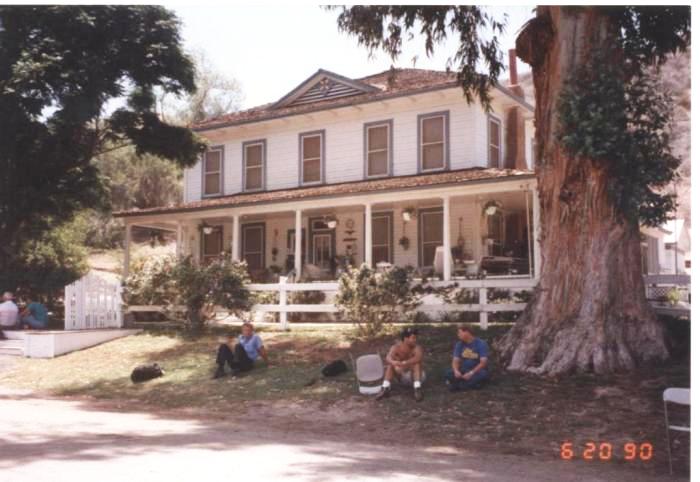
The Big House during Bill's visit in 1990. "The pictures show the exterior of the house as more ornate and with better paint than was the case when we were there. At that time, the entire house was a kind of battleship grey."
The house, now called the Big House, was apparently built in the 1890’s and it was especially grand for this isolated place. It is a square, two-story building with a wide veranda around the east and north sides. From the canyon road, one reaches the ground level of the house by some wooden steps, or by dismounting from a horse onto the horseblock, seldom used now, next to the steps, then going through a gate into a shallow front yard. Up more steps to the veranda leads to the front door, centered on the east side of the house and facing the canyon road. The front door opens to an entry hall that announces the mood of the interior: Ceilings about nine feet high, transom windows over all of the interior doors, ornate wood trim, area rugs on painted softwood floors; and, during our time there, pastel colored walls, wood trim painted white, gaslights in every room.
The entry hall opens on the left to the living room; on the right to the dining room, ahead on the left side to a wide stairway leading to the second level, and, right of that, ahead to a hallway leading to the rest of the first level. The kitchen, which is in the rear of the house, is accessible from the hallway and also from three passages to the dining room: a doorway, a butler’s pantry, and a window in a cook’s pantry. Maid’s quarters and another sitting room, also in the rear of the house, open to the hallway. Upstairs are five bedrooms and two bathrooms, the bathrooms fitted with large clawfoot tubs, pull-chain toilets, and alabaster sinks. Other than the bathrooms, each room has two, three or four double-hung windows, most of the panes showing their age through distortion due to early manufacturing techniques, each window with a total glass area about two feet wide by five feet high, and surrounded by wide, decorative molding. The bathrooms each have one such window. In the living room, dining room and two of the bedrooms are gas fireplaces with ornate wood mantles and plate glass mirrors. The dining room opens on the north side to the veranda. The outside door from the kitchen opens on the north side to a screen porch, which in turn opens to a lavatory with toilet only, and also opens through a trap door to a small cellar. The cellar, perhaps eight feet square, is for food storage. An icehouse, separate from the house, provides more food storage.
The gaslights, there until several years after we left, were the primary source of light; in each room there was a ceiling-mounted fixture with two glass chimneys and mantles. The light in the front hall had a large etched-glass chimney. Reading light for the roll-top desk in the dining room was provided by a wall-mounted gaslight on a swinging arm. Kerosene lamps – they were Aladdin mantle lamps powerful enough for comfortable reading at close range, and simple wick lamps – augmented the gas lights. There was an electric outlet in each of the kitchen and living room, used respectively for an electric iron and for reading lights, and an electric light on the front veranda. A separate building housed a laundry tub and a small power plant, whose capacity was 1500 watts, that served the washing machine and the outlets in the house. Fuel for the gaslights, the fireplaces, our gas-fueled Servel refrigerator and the power plant was natural gas piped directly from a well up the canyon.
My bedroom was the southwest corner room upstairs at the head of the stairway. It has two windows on the south wall, these providing a view up the canyon, and one on the west. My bed was next to a window on the south wall. From there, the view southward up the canyon takes the eye past Mustard Hill on the right – this is a hill terraced by cow paths and on which the mustard weed grows six feet high in a wet year – beyond the school house and past a water tank until the canyon winds to the right on its way westward. Imported trees planted in the early days of the village – most were eucalyptus, pepper or olive trees – provide some extra green and shade around the buildings and vacated building sites. In this view, morning comes with sunrise over the hills to the left.
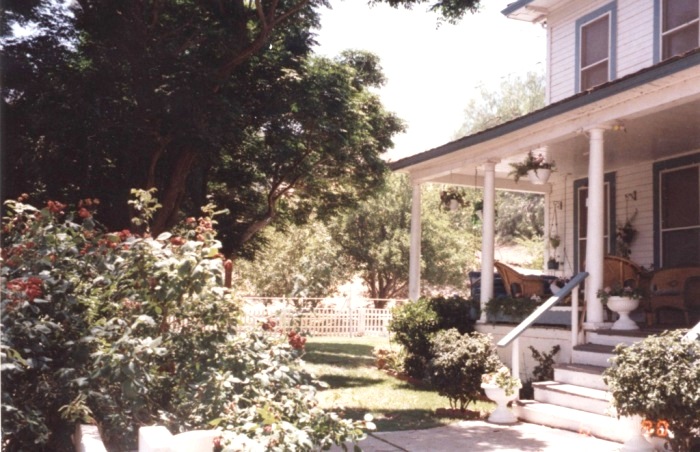
Often, when the days were long and my morning activity didn't start until after sunrise, and in the morning after it became easier to let my eyes stay open than to close them, I lay in bed propped up on my right elbow, looking up the canyon for signs of the day's beginning. Cattle, after spending the night around the barn, would amble single file up the canyon to their favorite grazing and napping places. In the hot weather, birds were active in the cool morning and then quiet with the heat. In the spring, mother hens began the days by walking their chicks out into the brush and up the gullies. Over several days, predators might cut the size of a hen's flock from twelve or thirteen to two or three, at which time the hen seemed to notice the change. There was a time when I was especially fond of watching a rooster and hen, easily identified by their markings, on their early morning promenade. They walked past the front yard side-by-side up the road, sometimes briskly with heads moving back and forth in, and then out of, unison. Just as often they chatted and stepped slowly, occasionally a step preceded by the suspension of a foot in midair as though its owner were awaiting the consequences of some complex calculation or emerging inspiration that would determine precisely the nature of that step.
From within the canyon, the hills that are its sides prevent views of sunsets down to a distant horizon. For me, those views were got by sitting on top of Mustard Hill and watching the sun go down, sometimes in a great last-time-forever blaze, over the hills of Ventura County. Sunset in the canyon gave way to a busy dusk – birds chattered as they settled down, bats zig-zagged around the trees and buildings, silhouettes and shadows changed rapidly with the receding sunlight – and then to darkness diminished only by moonlight or a dense coating of stars across the sky.
Coming around the last curve on this recent visit, Sherrean and I saw not what we expected, not just the sleepy little clump of buildings, perhaps with an animal or two napping in the shade, but people among the buildings, some cars, various pieces of equipment scattered around, and five or six large parked trailers. We parked, climbed through the gate at the entrance to the property and inquired about the activity.
On that summer morning, and for a few surrounding days, Mentryville was a location site for a movie; apparently it has been used for that on several occasions in recent years. The sun was hot, and hurrying was done slowly. Some people, spectators as well as extras awaiting a call, were just sitting in the shade, keeping cool while waiting for something to happen. Workers were moving equipment around apparently in preparation for the next shoot. Circumstances for that next scene were not obvious; it apparently was not to be near the house. The parked semi-trailers were for storage and dressing rooms.
In chatting with some of the bystanders, we were told that the movie was to be called "UFO Cafe" and that it would star Beau Bridges. Beyond that, our questions didn’t produce much. The bystanders were also waiting to find out more. The title of the movie explained the presence of several Little People among the extras waiting around.

UFO Cafe movie set in Mentryville (1990)
We walked among the buildings and I looked for evidence of my time there. The barn has long since been repainted, now to red with white trim, from the half-done whitewash job that I had left decades before. The chicken house is now a storage shed. There is a small barn under the big pepper tree where our '36 Chevy had sat until the engine rusted up. Part of the brick walkway that I laid around the house is intact; the fence in front of the house, which I built from two-by-six redwood storage tank staves, has been only partially replaced; the cattle guard that I made during a hot summer from two-inch pipe, fabric belting salvaged from an oil well, and eight-by-eight timber has been replaced by a more sturdy, all-metal version. The little house across the creek, and the footbridge leading to it, are gone.
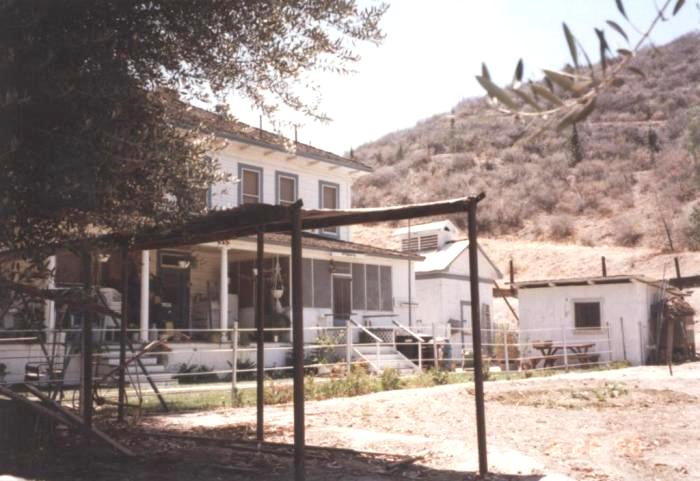
"The view from the yard shows a laundry house, on the right, where we had a wringer washing machine and a 1500 watt power plant. In the center is the ice house (very thick walls, loft for the ice), which we used for storage."
Eventually, after trying to see where the action was and not quite succeeding – most movie-making is a dull spectator activity for me, anyway – we went to the front gate of the yard, chatting as we went with extras and other folks. As we approached the house, one of the occupants, "Frenchy" Lagasse, came out. Several years before, after occupying the house since 1966, the Lagasses had arranged to get Mentryville recognized as a California Historical Landmark. Renovation of the buildings, including the schoolhouse, followed. I had last seen Frenchy when I was a teen-ager living there and he was an oil field worker. He didn't recognize me but remembered me when I introduced myself. After introduction to Sherrean, he invited us in to tour the house. It was cooled by refrigeration, and windows and doors were kept shut. Coming in to the chilly closeness of a refrigerated building from hot outdoors reminded me of summers that Sherrean and I had spent in Tempe, Arizona. By contrast, in a morning in such weather, to fit my memory, this old house should have been open on the shady sides to let the cooler morning air in, later to be closed up during the heat of the day, and still later to be opened for the evening air, all without the noise of air-conditioning.
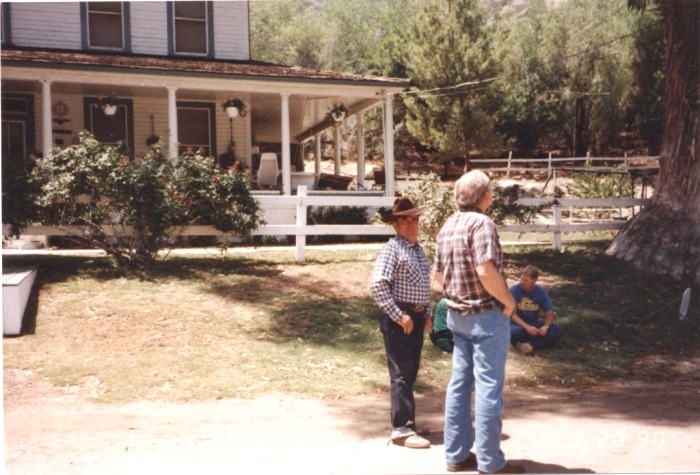
Bill looking up at the eucalyptus tree that has since been cut down. Frenchy Lagasse is standing next to him looking at the camera. "At the left edge of the picture is a view of a small part of the horse block, i.e. for mounting horses. When I rebuilt that, probably in summer of 1949, I tore up the first step (block is a combination of platform and stairway) and uncovered a gopher snake and a tarantula, apparently living in harmony".
Because of the recent restoration work, the building is in better condition than I remembered. It is now furnished and decorated to reflect the early part of this century. Much of the fabric is in dark colors and the windows are heavily draped; my parents had decorated in much lighter colors. Unfortunately, the gas light fixtures have been removed, ostensibly for reasons of safety. All of the rooms now have electrical outlets, that without need for a power plant. The power lines have found their way up the canyon.
My bedroom seemed close with the dark colors and busy prints; of course my desk is gone and the old family musket is no longer in its place. Nor are the dresser and mirror where, by the light of a kerosene lamp, I gave myself my first shave, my sister watching and reporting the progress to my parents downstairs. The view up the canyon was obstructed by heavy drapes only partially open and by the sheer panels behind them. The absence of the gaslights and kerosene lamps everywhere in the house was more noticeable than I would have expected, and was disappointing.
My glancing around comparing past with present, and the welling up of memories, were interrupted by a call to Frenchy, who excused himself and left. He had a role in the movie and was due to prepare for the next scene. I stood for a moment in the bedroom doorway where I had once waited for the Bakersfield-Tehachapi earthquake to stop shaking every board, window and gaslight in that old building. Then we left the house after some brief, pleasant talk with Carol Lagasse, Frenchy’s wife, and with some of the extras and workers outside. Our walk back to the car was for me the beginning of a pleasant decompression from a dense profusion of memories, mixed with looking around and with attempts to recall as I walked past the barn and barnyard.
We left Mentryville and the UFO Cafe, leaving behind some of the past and a little Hollywood fantasy. On retracing the road back out of Pico Canyon, I had a closer look at the townhouses that are creeping westward up the canyon from the edge of a field near Interstate Highway 5. There's something desperate in the appearance of the pueblo-like clusters of dwellings stuck on the sides of those bleak, dry hills, as though all other places for new housing have been used.
We headed north through the mountains and farmlands on Highway 5, past the Magic Mountain amusement park – more fantasy – to the Ridge Route and memories of trips when it was the narrow, winding road that was Highway 99 instead of the wide freeway that it is now, and when cars had no air-conditioning. The present began to return as we descended into the sea of land that is the San Joaquin Valley, and settled in for that long, go-ahead drive up I-5 through catatonia and to home to the Bay Area, where we have been since 1967.
1994 Update:
In 1994, the San Fernando Earthquake rippled north through the mountains and shook Mentryville very hard. When we visited there shortly after the earthquake, the house had been moved off of its brick foundation, chimneys had crumbled and the roof of the veranda hung against the walls, its pillars knocked loose by the earthquake.
Later, the property was sold by Standard Oil Company of California to the Santa Monica Mountains Conservancy. Rebuilding and renovation through private funding over several years have as a result the big house looking as it did, according to old photographs, when it was new. All of the trees surrounding the house are gone, probably from age but restoring the look of 1896, and perhaps to be replaced by new trees.
In 2007, from Highway 5 westward, the transformation of the dry land into suburban neighborhoods marches up the canyon, eventually to take a direction away from Mentryville and over the hills to the north and then to the bed of the Santa Clarita River.






